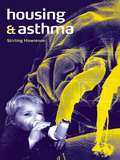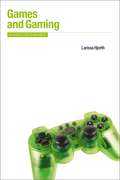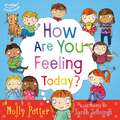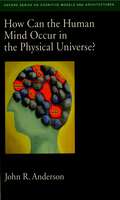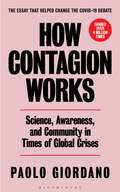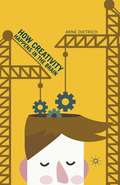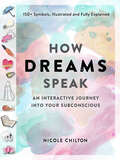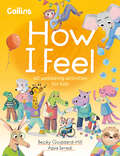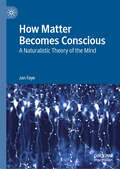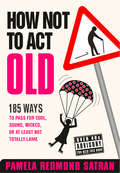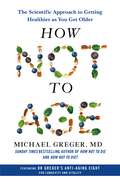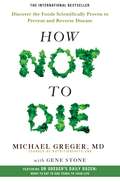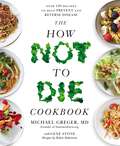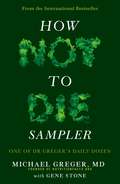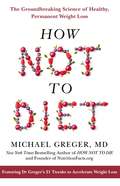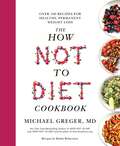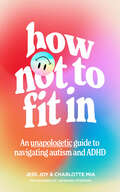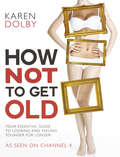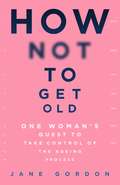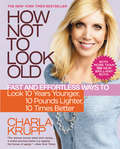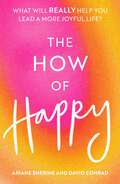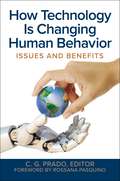- Table View
- List View
Housing and Asthma
by Stirling HowiesonAsthma is on the rise in a number of countries, in this volume Howieson asks what role the built environment has to play and what the construction industry can do to either slow the increase or reverse the trend. Based on the findings of a six-year research project, this book considers all aspects of housing to develop new strategies for dealing with the asthma pandemic in Britain and beyond. With the focus on the design and use pattern of our dwellings, the book looks at tackling the problems inherent in existing housing as well as forging guiding principles for the design of new dwellings, together with a financial assessment of the proposals.
How and When to Be Your Own Doctor
by Isabelle A. Moser Steve SolomonDr. Isabelle A. Moser and Steve Solomon collaborated on How and When to Be Your Own Doctor. When Solomon reached his late thirties, he began looking for healthy alternatives. He met Moser and began the practice of a yearly fast to cleanse his body. This book contains their combined knowledge on healing. Topics include How I Became a Hygienist, The Nature and Cause of Disease, Fasting, Colon Cleansing, Diet and Nutrition, Vitamins and Other Food Supplements and The Analysis of Disease States--Helping the Body Recover.
How are you feeling today?: A Let's Talk picture book to help young children understand their emotions
by Molly PotterWe all experience emotions and emotions are absolutely fine as long as we know what to do with them. Feelings arrive effortlessly enough but deciding what to do with them when they turn isn't so easy - especially when you are a child. Cue: this book! It provides children with several straightforward, entertaining and appropriate interactive ideas to help them deal with a selection of significant emotions.A great dip-in book where children can choose a feeling that relates to them and then turn to the page that provides child-friendly strategies for dealing with that feeling. Helpful parent notes at the back of the book provide more ideas for parents to use with their child and other strategies to try out together and practice the all important skill of dealing with feelings.
How are you feeling today?
by Molly Potter Sarah JenningsChildren have strong feeling and they can't always handle them very well. Perfect for sharing, How Are You Feeling Today? is packed with fun, imaginative ways to help children understand and cope with a whole range of different emotions. This delightful book gives parents the tools they need to help their child deal with those feelings - without it all ending in tears!A great dip-in book where children can choose a feeling that relates to them and then turn to the page that provides child-friendly strategies for dealing with that feeling. Helpful parent notes at the back of the book provide more ideas for parents to use with their child and other strategies to try out together and practice the all important skill of dealing with feelings.
How Babies Sleep: The Gentle, Science-Based Method to Help Your Baby Sleep Through the Night
by Sofia Axelrod'A clearly explained and reassuring guide from an expert in the field' Publisher's WeeklyDiscover the best baby sleep method - gentle, science-backed, and inspired by the latest Nobel Prize-winning research - that shows you how to get your baby to sleep through the night naturally.Sleep - or the lack of it - is one of the most crucial issues for new parents. Newborn babies typically wake every two to three hours, and there's nothing bleary-eyed, exhausted parents want more than a night of uninterrupted sleep. But while there's plenty of advice out there, there is nothing that's based on the latest cutting-edge research about sleep - until now.In How Babies Sleep, Sofia Axelrod, PhD - neuroscientist, sleep consultant, and mother of two -introduces the first baby sleep method that is truly rooted in the science of sleep. After having her first child, Axelrod realized that the typical baby sleep advice conflicted with the actual science of sleep, inlcuding the findings from her mentor's Nobel Prize-winning sleep lab. She developed her transformative method based on the latest discoveries about our body's circadian clock and how it is disturbed by light and other external stimuli. After seeing incredible results with her own babies, she has since counseled countless families in her groundbreaking method, which works with babies' needs and helps little ones learn to self-soothe, fall asleep more easily, and stay asleep through the night.You'll discover helpful tips that work, and learn: why using a red lightbulb (instead of a regular one) in the nursery at night can minimize wakings; why the age-old advice "don't wake a sleeping baby" isn't true; how to create a healthy routine; how to sleep train gently with minimal crying (under two minutes); and so much more in this revolutionary and effective book that will help both you and your baby enjoy a peaceful night's sleep.
How Can the Human Mind Occur in the Physical Universe? (Oxford Series on Cognitive Models and Architectures #3)
by John R. Anderson"The question for me is how can the human mind occur in the physical universe. We now know that the world is governed by physics. We now understand the way biology nestles comfortably within that. The issue is how will the mind do that as well."--Allen Newell, December 4, 1991, Carnegie Mellon University The argument John Anderson gives in this book was inspired by the passage above, from the last lecture by one of the pioneers of cognitive science. Newell describes what, for him, is the pivotal question of scientific inquiry, and Anderson gives an answer that is emerging from the study of brain and behavior. Humans share the same basic cognitive architecture with all primates, but they have evolved abilities to exercise abstract control over cognition and process more complex relational patterns. The human cognitive architecture consists of a set of largely independent modules associated with different brain regions. In this book, Anderson discusses in detail how these various modules can combine to produce behaviors as varied as driving a car and solving an algebraic equation, but focuses principally on two of the modules: the declarative and procedural. The declarative module involves a memory system that, moment by moment, attempts to give each person the most appropriate possible window into his or her past. The procedural module involves a central system that strives to develop a set of productions that will enable the most adaptive response from any state of the modules. Newell argued that the answer to his question must take the form of a cognitive architecture, and Anderson organizes his answer around the ACT-R architecture, but broadens it by bringing in research from all areas of cognitive science, including how recent work in brain imaging maps onto the cognitive architecture.
How Can the Human Mind Occur in the Physical Universe? (Oxford Series on Cognitive Models and Architectures #3)
by John R. Anderson"The question for me is how can the human mind occur in the physical universe. We now know that the world is governed by physics. We now understand the way biology nestles comfortably within that. The issue is how will the mind do that as well."--Allen Newell, December 4, 1991, Carnegie Mellon University The argument John Anderson gives in this book was inspired by the passage above, from the last lecture by one of the pioneers of cognitive science. Newell describes what, for him, is the pivotal question of scientific inquiry, and Anderson gives an answer that is emerging from the study of brain and behavior. Humans share the same basic cognitive architecture with all primates, but they have evolved abilities to exercise abstract control over cognition and process more complex relational patterns. The human cognitive architecture consists of a set of largely independent modules associated with different brain regions. In this book, Anderson discusses in detail how these various modules can combine to produce behaviors as varied as driving a car and solving an algebraic equation, but focuses principally on two of the modules: the declarative and procedural. The declarative module involves a memory system that, moment by moment, attempts to give each person the most appropriate possible window into his or her past. The procedural module involves a central system that strives to develop a set of productions that will enable the most adaptive response from any state of the modules. Newell argued that the answer to his question must take the form of a cognitive architecture, and Anderson organizes his answer around the ACT-R architecture, but broadens it by bringing in research from all areas of cognitive science, including how recent work in brain imaging maps onto the cognitive architecture.
How Contagion Works: Science, Awareness, and Community in Times of Global Crises - The Essay That Helped Change the Covid-19 Debate
by Paolo GiordanoThe groundbreaking, moving essay on the coronavirus pandemic shared over 4 million times in Italy and published in 25 countries around the world-which lucidly explains how disease spreads and how our interconnectedness will save us. "Lucid, calm, informed, directly helpful in trying to think about where we are now... The literature of the time after begins here." --Evening Standard (UK)In this extraordinarily elegant work written from lockdown in Italy as the crisis deepened day to day, Paolo Giordano, the internationally bestselling writer of The Solitude of Prime Numbers with a PhD in physics, shows us what this outbreak really is about: human interconnectedness.Illuminating the big picture of how the disease spreads with great simplicity and mathematical insight and placing it in the context of other modern crises like climate change and xenophobia, Giordano reveals how battling the pandemic is ultimately about realizing how inextricably linked all our lives are and acting accordingly.Both timely and timeless, How Contagion Works is an accessible, deeply felt meditation on what it means to confront this pandemic both as individuals and as a community and empowers us not to show fear in the face of it.
How Creativity Happens in the Brain
by Arne DietrichHow Creativity Happens In The Brain is about the brain mechanisms of creativity, how a grapefruit-sized heap of meat crackling with electricity manages to be so outrageously creative. It has a sharp focus: to stick exclusively to sound, mechanistic explanations and convey what we can, and cannot, say about how brains give rise to creative ideas.
How Dreams Speak: An Interactive Journey into Your Subconscious (150+ Symbols, Illustrated and Fully Explained)
by Nicole ChiltonPeek into your subconscious by learning to interpret 150 common dream symbols, beautifully illustrated in watercolor..
How I Feel: 40 Wellbeing Activities For Kids
by Collins Kids Becky Goddard-HillHelp young children to understand and talk about their feelings with this beautifully illustrated book of activities.
How Matter Becomes Conscious: A Naturalistic Theory of the Mind
by Jan FayeThis innovative book proposes a unique and original perspective on the nature of the mind and how phenomenal consciousness may arise in a physical world. From simple sentient organisms to complex self-reflective systems, Faye argues for a naturalistic-evolutionary approach to philosophy of mind and consciousness. Drawing on substantial literature in evolutionary biology and cognitive science, this book offers a promising alternative to the major theories of the mind-body problem: the quality of our experiences should not, as some philosophers have claimed, be associated with subjectivity that is not open for scientific explanation, nor should it be associated with intrinsic properties of the brain. Instead, Faye argues that mental properties are extrinsic properties of the brain caused by the organism’s interaction with its environment. Taking on the explanatory gap, and rejecting the ontological pluralism of present naturalist theories of the mind, Faye thus proposes a unified view of reality in which it is possible to explain qualitative mental presentations as part of the physical world.
How Not to Act Old: 185 Ways To Pass For Cool, Sound, Wicked, Or At Least Not Totally Lame
by Pamela Redmond SatranStill want to be cool but are afraid you no longer know how? Be not afraid – old is the new young!
How Not to Age: The Scientific Approach to Getting Healthier as You Get Older
by Michael GregerTHE SUNDAY TIMES BESTSELLERAs featured on the trending Netflix show You Are What You Eat.Live better for longer with this ultimate guide to longevity from the bestselling author of How Not to Die.We all want to stay healthy as we age but, with so many different claims out there, it can be hard to know the best advice to follow. In How Not to Age, Dr Michael Greger digs into the top peer-reviewed anti-ageing research to deliver a complete and optimal guide with simple steps to extend your lifespan and slow the adverse effects of ageing.Inspired by the dietary and lifestyle patterns of the world’s centenarians and residents of ‘blue zone’ regions where people live the longest, Dr Greger presents easy, evidence-based ways to preserve the body functions that keep us feeling youthful, both physically and mentally. Can an apple a day really keep the doctor away? What’s better for your longevity, jogging for four hours or eating two handfuls of nuts twice a week?Brimming with expertise, How Not to Age lays out practical strategies for living your longest, healthiest life – and for enjoying every moment of it.
How Not To Die: Discover the foods scientifically proven to prevent and reverse disease
by Gene Stone Dr Michael GregerThe International Bestseller'Dr Michael Greger reveals the foods that will help you live longer' Daily Mail'This book may help those who are susceptible to illnesses that can be prevented with proper nutrition' His Holiness the Dalai LamaWhy rely on drugs and surgery to cure you of life-threatening disease when the right decisions can prevent you from falling ill to begin with?How Not To Die gives effective, scientifically-proven nutritional advice to prevent our biggest killers - including heart disease, breast cancer, prostate cancer, high blood pressure and diabetes - and reveals the astounding health benefits that simple dietary choices can provide. Based on the latest scientific research, the internationally bestselling How Not To Die examines each of the most common diseases to reveal what, how and why different foods affect us, and how increasing our consumption of certain foods and avoiding others can dramatically reduce our risk of falling sick and even reverse the effects of disease. It also shares Dr Greger's 'Daily Dozen' - the twelve foods we should all eat every day to stay in the best of health.With emphasis on individual family health history and acknowledging that everyone needs something different, Dr Michael Greger offers practical dietary advice to help you live longer, healthier lives.
The How Not To Die Cookbook: Over 100 Recipes to Help Prevent and Reverse Disease
by Dr Michael GregerFrom the author of the global bestseller How Not To Die comes The How Not To Die Cookbook – a lavish, beautifully illustrated collection of delicious recipes based on the groundbreaking nutritional science of the original book. Dr Michael Greger, founder of the wildly popular website NutritionFacts, takes his comprehensive, lifesaving science into the kitchen. Why suffer from disease and ill health when the right food is proven to keep you healthy, and without the side effects of drugs? We can avoid heart disease, cancer and our other biggest killers if we use food as medicine, and the How Not To Die Cookbook offers a sustainable and delicious guide to preparing and eating the foods that will prevent and reverse fatal diseases.Featuring over 100 easy-to-follow, beautifully photographed plant-based recipes, with plenty of recipes suitable for vegetarians and vegans, the How Not To Die Cookbook merges cutting-edge science with everyday ingredients from the supermarket to help you and your family eat your way to better health and a longer life.
How Not To Die Sampler: One of Dr Greger's Daily Dozen
by Dr Michael GregerIn this sampler from the bestselling How Not To Die, we are offered an introduction and the first chapter, Beans, from Dr Michael Greger's Daily Dozen - the twelve foods we need to eat everyday to stave off disease and live healthier, longer lives.In the complete book How Not To Die, Dr Greger gives effective, scientifically-proven nutritional advice to prevent our biggest killers - heart disease, breast cancer, prostate cancer, high blood pressure, diabetes - and reveals the astounding health benefits that simple dietary choices can provide. The second half of the book is dedicated to Dr Greger's Daily Dozen, the twelve foods we need to eat everyday to stay well. Based on the very latest scientific research, How Not To Die reveals what, how and why different foods affect us and how increasing our consumption of certain foods and avoiding others can dramatically reduce our risk of falling sick and even reverse the effects of disease.
How Not To Diet: The Groundbreaking Science of Healthy, Permanent Weight Loss
by Michael GregerPut an end to dieting and replace weight-loss struggles with this easy approach to a healthy, plant-based lifestyle, from the bestselling author of How Not to Die.Every month seems to bring a trendy new diet or a new fad to try in order to lose weight – but these diets aren’t making us any happier or healthier. As obesity rates and associated disease and impairments continue to rise, it’s time for a different approach.How Not to Diet is a treasure trove of buried data and cutting-edge dietary research that Dr Michael Greger has translated into accessible, actionable advice with exciting tools and tricks that will help you to safely lose weight and eliminate unwanted body fat – for good.Dr Greger, renowned nutrition expert, physician, and founder of nutritionfacts.org, explores the many causes of obesity – from our genes to the portions on our plate to other environmental factors – and the many consequences, from diabetes to cancer to mental health issues. From there, Dr Greger breaks down a variety of approaches to weight loss, honing in on the optimal criteria that enable success, including: a diet high in fibre and water, a diet low in fat, salt, and sugar, and diet full of anti-inflammatory foods.How Not to Diet then goes beyond food to explore the many other weight-loss accelerators available to us in our body’s systems, revealing how plant-based meals can be eaten at specific times to maximize our bodies’ natural fat-burning activities. Dr Greger provides a clear plan not only for the ultimate weight loss diet, but also the approach we must take to unlock its greatest efficacy.
The How Not To Diet Cookbook: Over 100 Recipes for Healthy, Permanent Weight Loss
by Michael GregerFrom Michael Greger, M.D., the author of the New York Times bestseller How Not to Die, comes a full-color, fully illustrated cookbook that shares the science of long-term weight-loss success.Greger offers readers delicious yet healthy options that allow them to ditch the idea of 'dieting' altogether. As outlined in his book How Not to Diet, Greger believes that identifying the twenty-one weight-loss accelerators in our bodies and incorporating new, cutting-edge medical discoveries are integral in putting an end to the all-consuming activity of counting calories and getting involved in expensive juice cleanses and Weight Watchers schemes.The How Not to Diet Cookbook is a revolutionary addition to the cookbook industry: incredibly effective and designed for everyone looking to make changes to their dietary habits to improve their quality of life.
How Not to Fit In: An Unapologetic Guide To Navigating Autism And Adhd
by Jess Joy Charlotte Mia’The lack of information around how ADHD and autism shows up in adults means that many of us have been assuming we were anxious, not working hard enough, or just entirely failing altogether.’ – Jess Joy and Charlotte Mia
How Not to Get Old
by Karen DolbyAt last! The book that gives you all the facts about how to defy the signs of ageing. Are you worried about the way a particular part of your body is ageing? Would you like to prevent the appearance of wrinkles? Get your flat, pre-kids tummy back? Have whiter teeth but are unsure about which procedure to choose? Presented by Anna Richardson, How Not to Get Old is the new Channel 4 programme that will tell you everything you need to know about, well, how not to get old.This beautifully designed book will be published to coincide with the first series of the show and will look at all the anti-ageing treatments available, helping you to make an informed choice about how you might want to improve the appearance of a part of your body as it ages. For example, if you are unhappy with how your bust is looking, should you be considering bust-lifting creams or surgery - or would specific exercises be enough? As well as taking a complete look at all of the procedures and treatments available, How Not to Get Old will be packed with vital information such as expert advice on what you should know before you go ahead with a procedure, pioneering techniques that are being developed around the world and whether the more expensive products on the market are actually any more effective than the high-street brands.You won't want to grow old without it!
How Not To Get Old: One Woman’s Quest to Take Control of the Ageing Process
by Jane GordonWhen journalist Jane Gordon was hospitalised and left immobile after a nasty car accident, dependent on others to feed her and help her to the bathroom, she suddenly had to confront what it might be like to one day be old and infirm. Determined to not only regain her strength but find ways to stay physically and mentally fit for as long as possible, Jane decided to road-test different self-help programmes designed to promote longevity. From ballroom dancing to brain training, learning a second language to silent meditation, joining the gym and improving her gut health, Jane seeks advice from top neuroscientists and medical professionals to assess the impact these courses have on her health, and whether they will stop her getting old before her time. Part self-help, part manifesto, How Not To Get Old is about future-proofing your physical and mental wellbeing and taking control of the ageing process, rather than wallowing in it. For what begins as a clever experiment in the art of stopping time becomes a joyous celebration of what we CAN do, not what we can't or shouldn't, and ultimately demonstrates how later life is still very much for living...
How Not to Look Old: Fast and Effortless Ways to Look 10 Years Younger, 10 Pounds Lighter, 10 Times Better
by Charla KruppForget getting older gracefully--This is the beauty and style bible every woman has been waiting for!HOW NOT TO LOOK OLD is the first--ever cheat sheet of to-dos and fast fixes that pay-off big time--all from Charla and her friends, the best hair pros, makeup artists, designers, dermatologists, cosmetic dentists and personal shoppers in the biz. Packed with eye-opening details on hair color, brows, lipstick, wrinkle-erasers, jeans, shapewear, jewelry, heels, and more, the book speaks to every woman: from low maintenance types who don't want to spend a fortune or tons of time on her looks to high maintenance women who believe in looking fabulous at any price. There's also too-old vs. just-right before and after photos, celebrity examples of good and bad style, shopping lists of Charla's brilliant buys in fashion and beauty products, coveted addresses of "Where the top beauty pros go," fun sidebars--and more. Known to national audiences from her ten years on NBC's Today show, style expert Charla Krupp dishes out her secrets in this "ultimate" to-do list for looking hip and fabulous -- no matter what your age.
The How of Happy: What will REALLY help you lead a more joyful life?
by Ariane Sherine David ConradHappiness: as elusive as a working inkjet printer, and as slippery as an eel covered in baby oil. When we chase happiness, it runs away like a cat when you're trying to give it a bath, but the world of pop psychology is filled with competing advice that either claims it can help you catch it or warns you not to seek it out at all. Comedian Ariane Sherine is determined to help us find the true path to happiness, and public health expert David Conrad has the key: 50 well-selected research studies that show you exactly what to do to find happiness in your relationships, your friendships, your finances, your sex life and your career. Using wide-ranging evidence from around the world, Conrad and Sherine show us the true science behind what makes people happy and outline the simple, practical steps we can take to attain this too. This book has all the facts, stats and entertainment you could ever need to live a blissfully content life. And celebrities weigh in with their own versions of happiness too, so you'll find contributions from Derren Brown, Stewart Lee, Jeremy Vine, Rosie Holt, Femi Oluwole, Robin Ince, Sanjeev Kohli, Bec Hill, Arthur Smith and many more.
How Technology Is Changing Human Behavior: Issues and Benefits
by C. G. PradoExplains some of the ways in which technological advances are altering, for better or worse, large-scale human behavior, thought processes, and critical thinking skills.Recent technological advances—from dating apps to artificial insemination, from "smart" phones to portable computers that can instantly search the World Wide Web for information, and from robots performing surgery to cars driving themselves—once remarkable, have become an unremarkable part of our lives. The team of authors of this book asks, "How are they changing us?" We all recognize that these innovations have altered our lives, often making them easier, but it is also important to ask if we have lost anything while we have gained from them. The authors of How Technology Is Changing Human Behavior: Issues and Benefits show that human behaviors and thinking skills are rapidly being reprogrammed by technology, with even more developments on the horizon sure to further alter our future and shape our identity.
